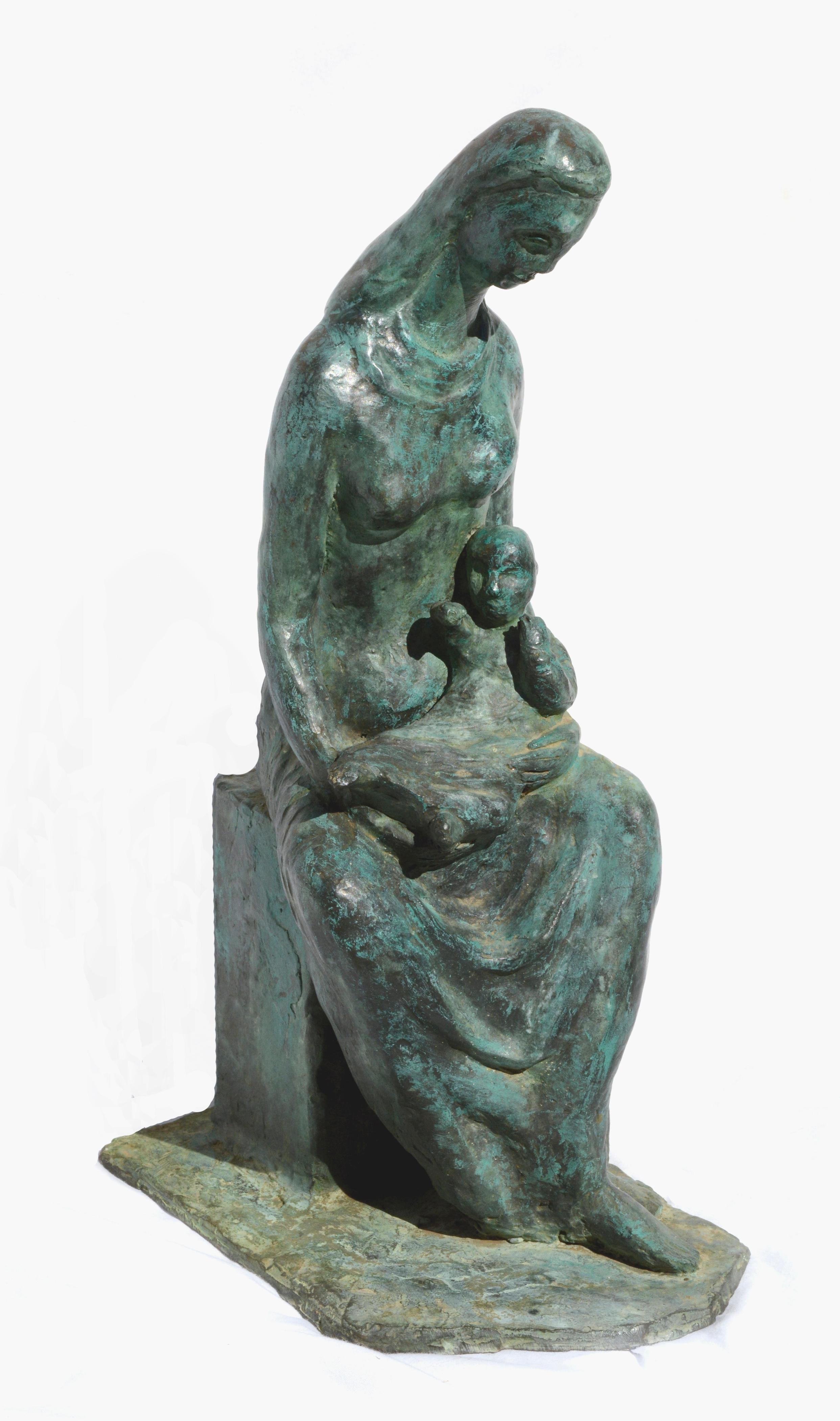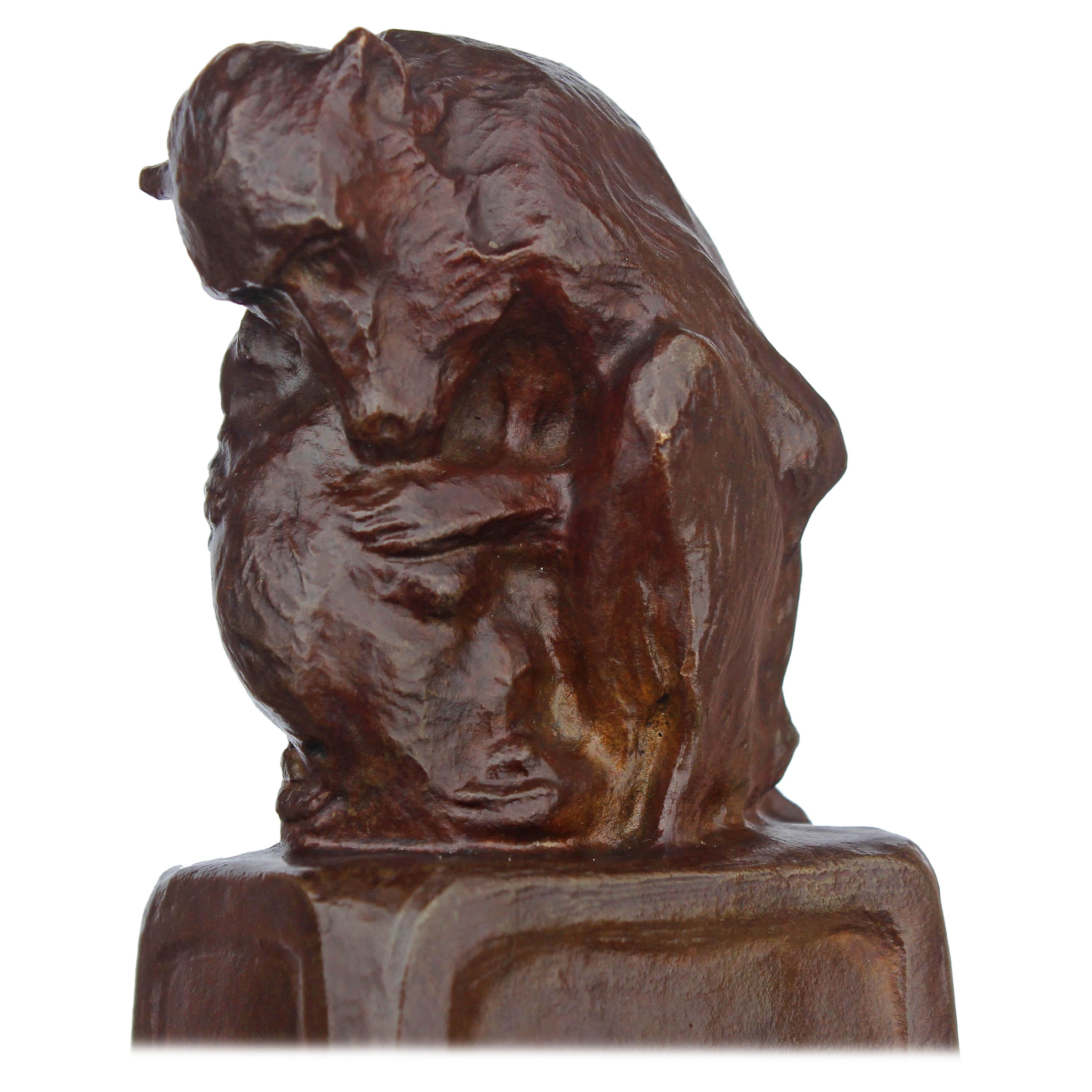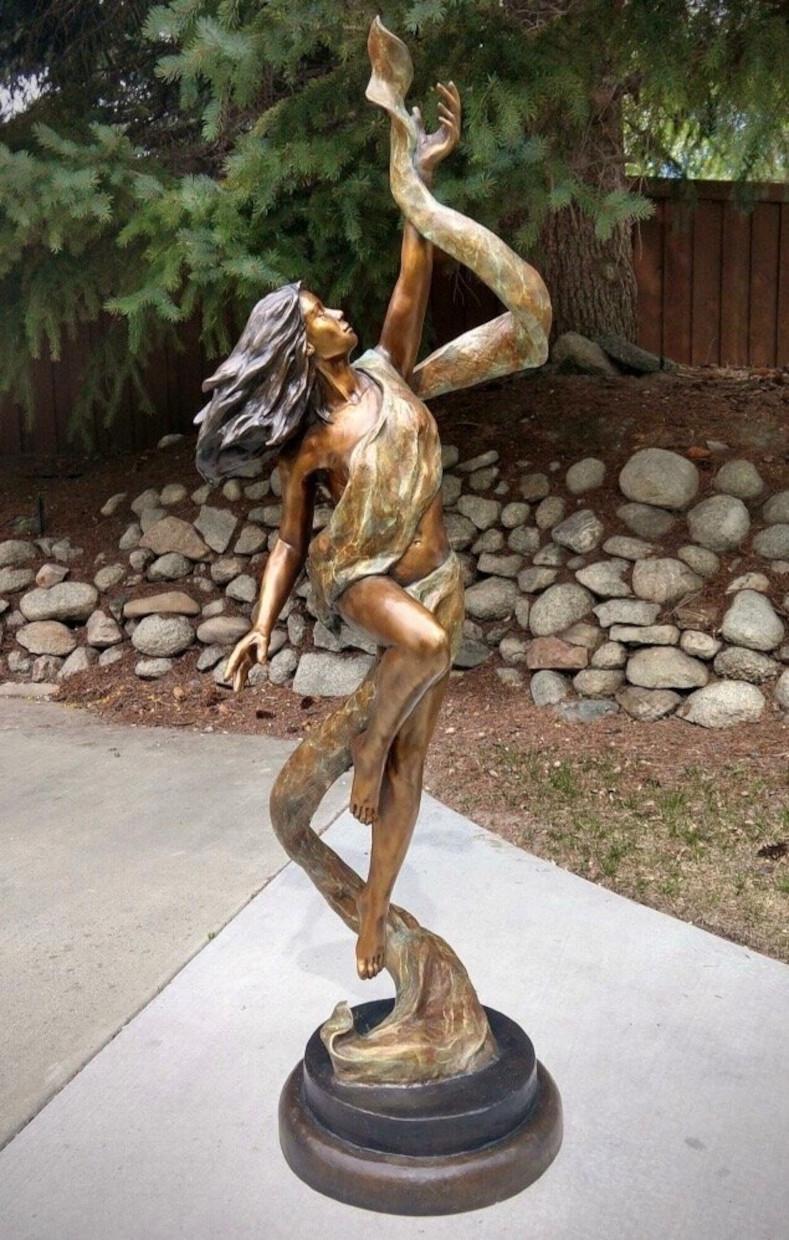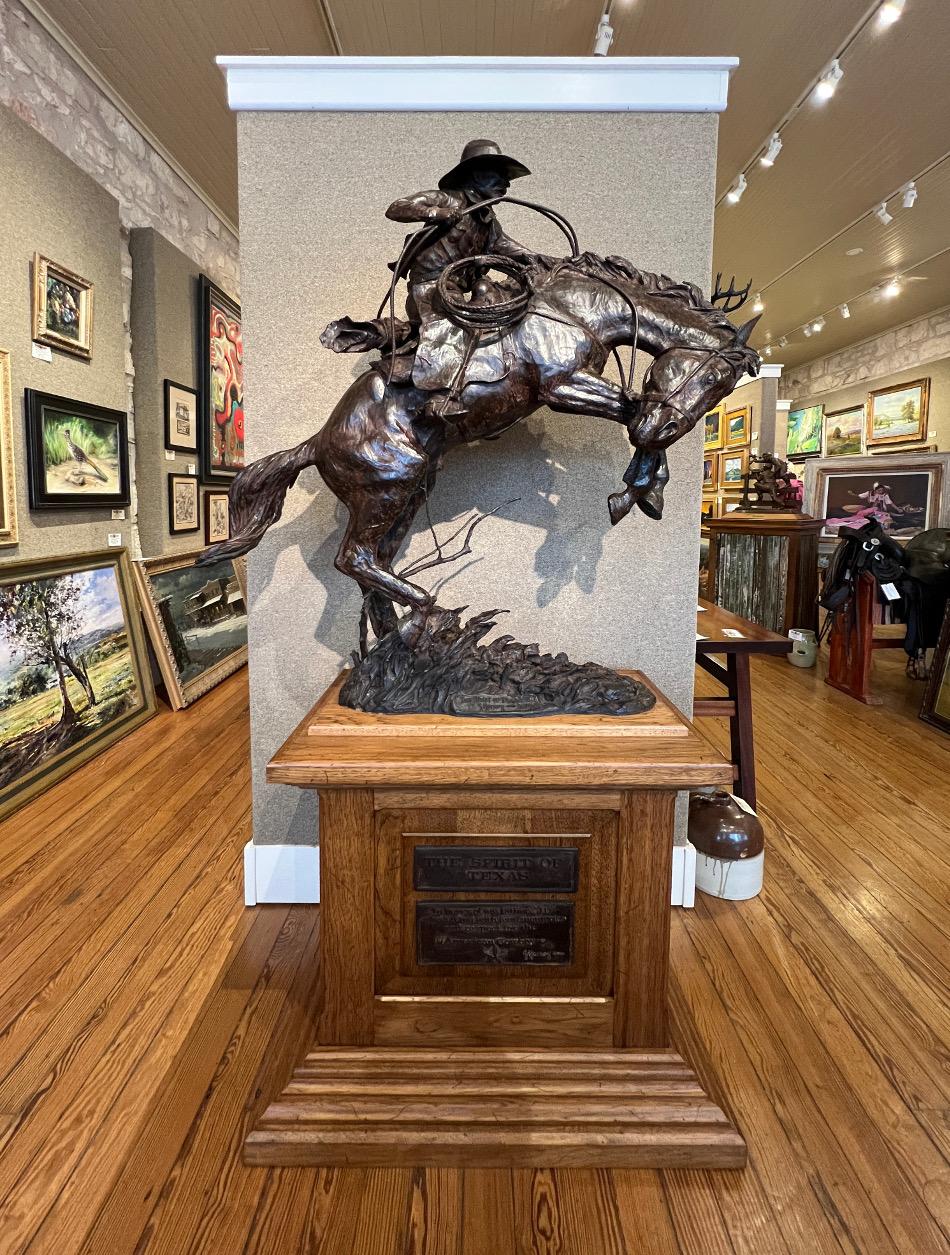Edgar DegasEdgard Degas: Horse Clearing an Obstacle (work 48 /certified by Comité Degas)c.1887–8
c.1887–8
About the Item
- Creator:Edgar Degas (1834-1917, French)
- Creation Year:c.1887–8
- Dimensions:Height: 11.42 in (29 cm)Width: 12.21 in (31 cm)Depth: 9.85 in (25 cm)
- Medium:
- Movement & Style:
- Period:
- Condition:
- Gallery Location:Gent, BE
- Reference Number:1stDibs: LU2140210993122
Edgar Degas
Edgar Degas, born Hilaire-Germain-Edgar De Gas in Paris in 1834, was the oldest of five children of Célestine Musson De Gas, a Creole from New Orleans, and Augustin De Gas, a banker. Degas began his schooling at age eleven, enrolling in the Lycée Louis-le-Grand, but after his mother died when he was thirteen, his father and grandfather became the main influences on him for the remainder of his youth.
Upon graduating the Lycée in 1853, at age 18, he registered as a copyist in the Louvre Museum, but his father expected him to go to law school. Degas duly enrolled at the faculty of law of the University of Paris, in November 1853, but applied little effort to his studies. In 1855, Degas met Jean-Auguste-Dominique Ingres, whose advice he never forgot: “Draw lines, young man, and still more lines, both from life and from memory, and you will become a good artist.” In April of that year, Degas was admitted to the École des Beaux-Arts.
Evidence of Degas’ classical education can be seen in his early painting, Young Spartans Exercising (ca. 1860; National Gallery, London), done while he was still in his twenties. After 1865, when the Salon accepted his history painting The Misfortunes of the City of Orléans (Musée d'Orsay, Paris), Degas did not paint Academic subjects again, focusing his attention on scenes of modern life. He began to paint scenes of such urban leisure activities as horse racing and, after about 1870, of café-concert singers and ballet dancers. Degas' interest in ballet dancers intensified in the 1870s, and eventually he produced approximately 1,500 works on the subject. These are not traditional portraits, but studies that address the movement of the human body, exploring the physicality and discipline of the dancers through the use of contorted postures and unexpected vantage points.
Following the opening of trade with Japan in 1854, many French artists, including Degas, were increasingly influenced by Japanese prints. Degas abstracted from these prints their inventive compositions and points of view, particularly in his use of cropping and asymmetry [Dancers Practicing at the Bar (1877); Dancers, Pink and Green (ca. 1890)]. He also observed how sixteenth-century Italian Mannerists similarly framed their subjects, sometimes cutting off part of a figure.
Degas had an interest in a wide range of media, including engraving, monotype, and photography. Before 1880, he generally used oils for his completed works, but after 1875, he began using pastels more frequently, even in finished works such as Portraits at the Stock Exchange (1876). He submitted a suite of nudes, all rendered in pastel, to the final Impressionist exhibition in 1886; among these was Woman Bathing in a Shallow Tub (1885). The figures in these pastels were criticized for their ungainly poses.
By the late 1880s, Degas’s eyesight had begun to fail, perhaps as a result of an injury suffered during his service in defending Paris during the Franco-Prussian War of 1870–71. After that time he focused almost exclusively on dancers and nudes, increasingly turning to sculpture. Degas continued working as late as 1912, when he was forced to leave the studio in Montmartre in which he had labored for more than twenty years. He died five years later in 1917, at the age of eighty-three.
Find original Edgar Degas drawings, prints, paintings and other art on 1stDibs.
(Biography provided by Stern Pissarro Gallery)
- ShippingRetrieving quote...Ships From: Gent, Belgium
- Return PolicyA return for this item may be initiated within 10 days of delivery.
- Certified Edgard Degas Bronze of a horse : (Horse walking at a high pace)By Edgar DegasLocated in Gent, VOVCheval marchant au pas relevé is one of the artist’s most elegant and exacting models of a horse. It underscores Degas’s deep understanding of equine anatomy and his ability to render it with lightness and charm. Known for his focus on contemporary subjects, Degas first began depicting horses in the 1860s. As a member of the prestigious Jockey Club in Paris, Degas was a habitué of the racecourses at Deauville and Longchamps, where he could study the beauty of thoroughbred horses at close quarters. Although the artist was not an active participant himself, equestrian sports fascinated Degas throughout his life, as it allowed him to capture the full range of the horse’s movement in a wealth of poses. Bronze with dark brown patina bearing the stamp of the signature "Degas", numbered IV/IX and dated 1998. Posthumous lost wax casting as of 1998. Stamp of Valsuani. The work is a sought-after rarity in terms of Degas’ sculptures. This bronze is distinguished by the fact that it is a Valsuani bronze, meaning it faithfully records Degas’ wax version’s as it appeared at the time of its creation. Most Degas' bronzes that are found on the market were cast by Hébrard – these serialized bronzes are surmoulages, or “aftercasts,” that were cast from the modèle bronzes currently in the Norton Simon Museum (Pasadena). Because these bronzes are second generation, they are smaller and far less detailed than the current bronze. This example, however, was cast by Valsuani from a plaster that was taken directly from Degas’ waxes, according to scholarship by the art historian Dr. Gregory Hedberg. These plasters were created by Degas’ sculptor friend Albert Bartholomé shortly after Degas completed his wax figurines. Thus, they record the earliest versions of Degas’ wax sculptures, before they were damaged by time or handling, and before Degas himself altered the works. The Hébrard bronzes...Category
1880s Impressionist Figurative Sculptures
MaterialsBronze
- Animal Bronze: Lying eagle by Alberic Collin (close friend of Rembrandt Bugatti)Located in Gent, VOVNumbered 1/8 Cast Fonderie Rocher A fine cast with a vivid green patina of a bird of preyCategory
1930s Nude Sculptures
MaterialsBronze
- Roaring LionnessLocated in Gent, VOVA fine quality, twentieth-century bronze model of a roaring lioness by Alberic Collin (Belgian 1886-1962). Prior to casting by the Valsuani foundry it w...Category
1930s Art Deco Figurative Sculptures
MaterialsBronze
- Italian Animal Bronze : Battling Rams by Sirio TofanariLocated in Gent, VOVA very rare bronze cast of two battling Rams, by Sirio Tofanari (1886-1969). An old cast with a dark brown shaded patina. On a heavy green marble steppe...Category
1930s Art Deco Figurative Sculptures
MaterialsMarble, Bronze
- Sea Lion by Greta van Puyenbroeck (1943- )Located in Gent, VOVsea lion Artist: Greta van Puyenbroeck Dimensions: 22 h x 44 l x 30 cm w without base with base 29 x 33 x 38 cm Foundry: Artcasting Sign Greta Van Puyenbroeck was born in Antwerp in ...Category
20th Century Figurative Sculptures
MaterialsBronze
- A pair of ducks by Carl August Brasch.Located in Gent, VOVA very finely detailed and stylized bronze sculpture of a pair of ducks on a marble plinth. Signed C. Brasch. In terms of approach and style, this work is modern and somewhat reminis...Category
20th Century Figurative Sculptures
MaterialsMarble, Bronze
- Mother and Child Bronze SculptureBy Rose Van VrankenLocated in Soquel, CAExpressive bronze sculpture of a mother holding an infant by Rose Van Vranken (American, 1918-2013). Signed and numbered "VAN VRANKEN 5/6" on the back of the pedestal. 14.5"H x 5.5"...Category
Mid-20th Century American Impressionist Figurative Sculptures
MaterialsBronze
- Bronze Sculpture "Mother and Child" Baboons by Blanca WillLocated in Rochester, NY"Mother and Child" an impressionist bronze sculpture of baboons by sculptor Blanca Will, American, 1881-1978, dated 1912. Works by Will are rare. Blanca Will Exhibited at the National Academy of Design, Pennsylvania Academy of Fine Arts...Category
Early 20th Century Impressionist Figurative Sculptures
MaterialsBronze
- "PRECIOUS CARGO" LITTLE GIRL AND HER DOG LIFE SIZEBy ScyLocated in San Antonio, TXScy Colorado Artist Image Size: 32 x 30 x 15 Medium: Bronze "Precious Cargo" Scy has been surrounded by fine art throughout her entire life. She grew up beside the easel and sculpting stand...Category
2010s Impressionist Figurative Sculptures
MaterialsBronze
- "ZENITH" 5 FEET TALL BEAUTIFUL DRAPED NUDE REACHING FOR THE HEAVENS. A/PBy ScyLocated in San Antonio, TXScy Texas Artist Size: 5 feet tall. Medium: Bronze Artist Proof / 44 "Zenith" Scy has been surrounded by fine art throughout her entire life. She grew up beside the easel and sculpting stand...Category
2010s Impressionist Figurative Sculptures
MaterialsBronze
- " THE SPIRIT OF TEXAS " HUGE, 81" TALL BRONZE BUCKING BRONCO COWBOY WESTERNBy G. HarveyLocated in San Antonio, TXG. Harvey (Gerald Harvey Jones) (1933-2017) San Antonio, Austin, and Fredericksburg Artist Image Size: 81 Inches Tall Medium: Bronze Sculpture Dated 2006 "The Spirit Of Texas" Bucking Bronco & Rider They are very scarce. I only know about 2 others that have even come up for sale in the last 10 years or so. Please not the dedication on the wooden base of the sculpture. There is one on Gerald Harvey Jones (G. Harvey) tombstone in the Texas State Cemetery in Austin, Texas. Western, Cowboy, Horse, Bronc, Bronco Riata, Rodeo G. Harvey (Gerald Harvey Jones) (1933-2017) Known for paintings closely linked in mood and subject matter to Edouard Cortes [1882-1962], G Harvey creates romanticized street scenes of turn of the century towns in America. Rain slick streets reflect urban lights, and the weather is obviously cold. He grew up in the rugged hills north of San Antonio, Texas from where herds of longhorn cattle were once driven up dusty trails to the Kansas railheads. His grandfather was a trail boss at 18 and helped create an American legend for his grandson. So the American West is not only the artist's inspiration but his birthright. Harvey's early interest in sketching and drawing slowly evolved into a passion for painting in oils. After graduating cum laude from North Texas State University, Harvey took a position with the University of Texas in Austin, but he soon realized that weekends and nights at the easel did not satisfy his love of painting. He abandoned the security of a full-time job in 1963 and threw his total energy into a fine art career. Harvey paints the spirit of America from its western hills and prairies to the commerce of its great cities. His original paintings and bronze sculptures are in the collections of major corporations, prestigious museums, the United States government, American presidents, governors, foreign leader and captains of industry. The Smithsonian Institution chose Harvey to paint The Smithsonian Dream, commemorating its 150th Anniversary. The Christmas Pageant of Peace commissioned Harvey to create a painting celebrating this national event. He has been the recipient of innumerable awards and the subject of three books. G. Harvey lived in Fredericksburg, Texas, with his wife Pat in a 150-year-old stone home built by German settlers. His studio and residence are nestled within the Historic District of Fredericksburg. It is obligation of fine artists to present us with more than pretty pictures. They must also make us feel. Among the western painters of today, there is none more capable of accomplishing this than G. Harvey. In his paintings, the viewer into only sees the physical elements of his subject, but also senses the mood that surrounds them. It is a remarkable aspect of fine art, which few artists are able to master. Gerald Harvey Jones was born in San Antonio, Texas, in 1933. His grandfather was a cowboy during the trail-driving era when legends grew up along the dusty trails north from Texas. Family stories of wild cattle and tough men were absorbed by a wide-eyed boy and became the genesis of G. Harvey's art. A graduate in fine arts at North Texas State University, Harvey taught full-time and painted nights and weekends for several years. It was through painting that he found his greatest satisfaction, and his native central Texas hill country provided the inspiration for most of his earliest work. With the development of his talent and the growth of his following, Harvey began to expand his artistic horizons. He left teaching and concentrated on a career in fine art. He sought the essence that is Texas and found it not only along the banks of the Guadalupe, but in cow camps west of the Pecos, and in the shadows of tall buildings in big Texas cities. The streets of Dallas once echoed with the sound of horse hooves and the jingle of spurs. Historic photographs reveal what it looked like, but only an artist like Harvey can enable a viewer to experience the mood and flavor or the time. Contemporary western art has too often centered on the literal representations from its roots in illustrations. Artists like G. Harvey take us a step further, to the subjective impressions that are unique to each great talent and which constitutes something special and basic to fine art expression. Harvey was a soft-spoken and unassuming man who cared deeply about what he painted without becoming maudlin or melodramatic. We sense there is more in each Harvey painting than just that which is confined to the canvas. Resources include: The American West: Legendary Artists of the Frontier, Dr. Rick Stewart, Hawthorne Publishing Company, 1986 Artist G. Harvey grew up in the rugged hills north of San Antonio, Texas from where herds of longhorn cattle were once driven up dusty trails to the Kansas railheads. His grandfather was a trail boss at 18 and helped create an American legend. The American West is not only the artist's inspiration but his birthright. Harvey's early interest in sketching and drawing slowly evolved into a passion for painting in oils. After graduation cum laude from North Texas State University, Harvey took a position with the University of Texas in Austin, but he soon realized that weekends and nights at the easel did not satisfy his love of painting. He abandoned the security of a full-time job in 1963 and threw his total energy into a fine art career. Two years as a struggling artist followed, but 1965 brought acclaim for the artist's first prestigious show, The Grand National exhibition in New York, and the American Artists' Professional League presented him with their New Master's Award. President Lyndon Johnson discovered his fellow Texan's talent, became a Harvey collector and introduced John Connally to the artist's work. Connally was enthusiastic about Harvey's art, and, on one occasion, he presented a G. Harvey original to each governor of Mexico's four northern states. Harvey paints the spirit of America from its western hills and prairies to the commerce of its great cities. His original paintings and bronze sculptures are in the collections of major corporations, prestigious museums, the United States government, American presidents, governors, foreign leader and captains of industry. The Smithsonian Institution chose Harvey to paint The Smithsonian Dream commemorating its 150th Anniversary. The Christmas Pageant of Peace commissioned Harvey to create a painting celebrating this national event. He has been the recipient of innumerable awards and the subject of three books. Through his art, our history lives. Gerald Harvey Jones, better known as G. Harvey, grew up in the Texas Hill Country listening to his father and grandfather tell stories about ranch life, frontier days in Texas, and driving cattle across the Red River. Early in his career, he began to draw inspiration from that collective memory for paintings that would eventually earn him the reputation as one of America's most recognized and successful artists. His art is rooted in the scenic beauty of the land he grew up in and the staunch independence of the people who live there. He says, "My paintings have never been literal representations. They are part first-hand experience, and part dreams generated by those early stories I heard. They are a product of every place I have been, everything I have ever seen and heard." G. Harvey graduated from North Texas State University. He taught in Austin, but continued to study art in his spare time, eventually devoting full time to his painting. The year 1965 was a turning point when he won the prestigious New Masters Award in the American Artist Professional League Grand National Exhibition in New York. It is often said that in viewing a work of art, one is granted a unique look into the thoughts and expressions of values that give meaning to the artist work. Nowhere does this ring truer than the art of G. Harvey. Though Harvey has had nearly two decades of sell-out shows, an outstanding honor came with a series of one-man shows in Washington, D.C. in 1991. The first was at the National Archives featuring his paintings of the Civil War era, then a selection of paintings of notable Washington landmarks was exhibited at the Treasury Department, culminating in a one-man show of 35 paintings at the Smithsonian Institution during their exhibition of The All-American Horse. His work was featured in Gilcrease Museum exhibitions from 1992-1997. In 1987 his alma matter...Category
Early 2000s Impressionist Figurative Sculptures
MaterialsBronze
- “Ane d’Afrique” African Donkey bronze by Auguste Cain, Susse foundryBy Auguste CainLocated in PARIS, FRCharming little bronze by the great animal sculptor Auguste-Nicolas Cain, signed A.Cain on the side, inscribed Ane d’Afrique (Donkey from Africa) and Susse Fres on the terrace. The...Category
1870s Impressionist Figurative Sculptures
MaterialsBronze






